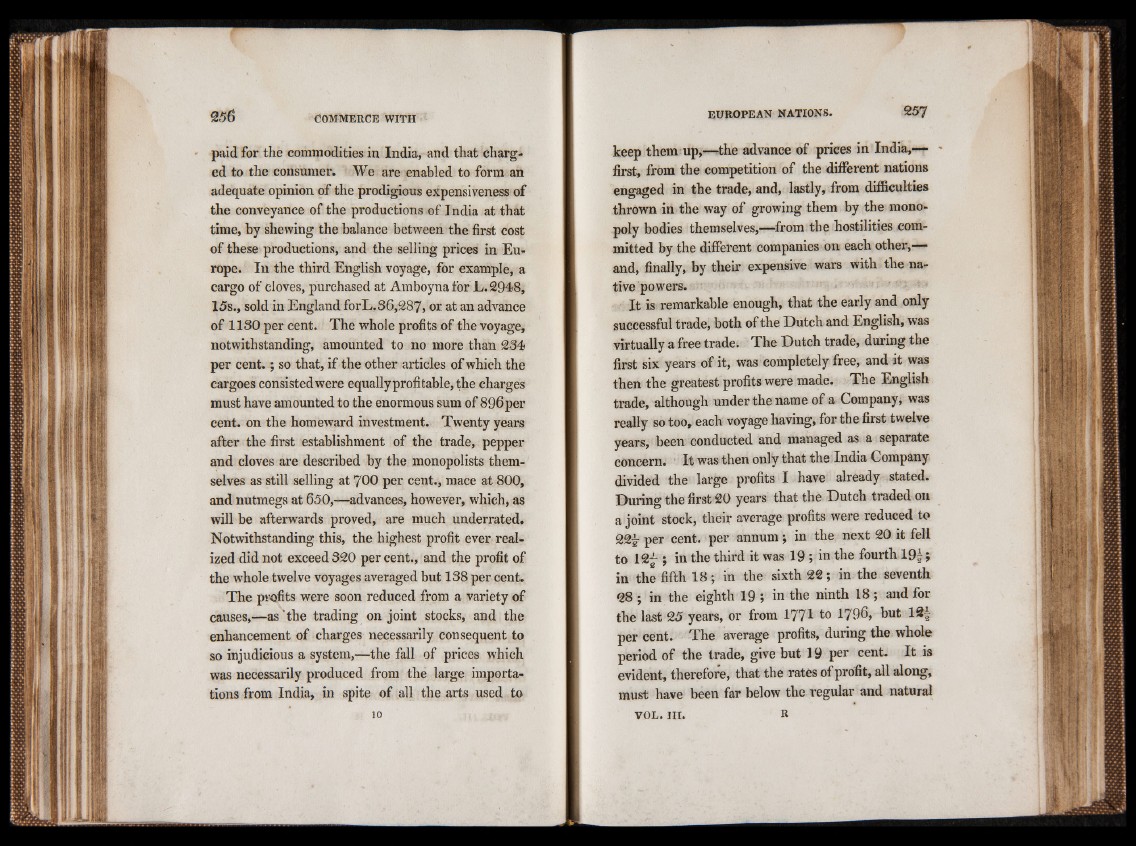
Co m m e r c e w it h
paid for tlie commodities in India, and that charged
to the consumer. We are enabled to form an
adequate opinion of the prodigious expensiveness of
the conveyance of the productions of India at that
time, by shewing the balance between the first cost
of these productions, and the selling prices in Europe.
In the third English voyage, for example, a
cargo of cloves, purchased at Amboyna for L. 2948,
15s., sold in England forL.36,287, or at an advance
of 1 ISO per cent. The whole profits of the voyage,
notwithstanding, amounted to no more than 234
per cent.; so that, if the other articles of which the
cargoes consisted were equallyprofitable,the charges
must have amounted to the enormous sum of 896per
cent, on the homeward investment. Twenty years
after the first establishment of the trade, pepper
and cloves are described by the monopolists themselves
as still selling at 700 per cent., mace at 800,
and nutmegs at 650,—advances, however, which, as
will be afterwards proved, are much underrated.
Notwithstanding this, the highest profit ever realized
did not exceed 320 per cent., and the profit of
the whole twelve voyages averaged but 138 per cent.
The profits were soon reduced from a variety of
causes,—as the trading on joint stocks, and the
enhancement of charges necessarily consequent to
so injudicious a system,—the fall of prices which
was necessarily produced from the large importations
from India, in spite of all the arts used to
10
EUROPEAN NATIONS. 257
keep them up,-—the advance of prices in India,—
first, from the competition of the different nations
engaged in the trade, and, lastly, from difficulties
thrown in the way of growing them by the monopoly
bodies themselves,—from the hostilities committed
by the different companies on each other,—
and, finally, by their expensive wars with the native
powers.
It is remarkable enough, that the early and only
successful trade, both of the Dutch and English, was
virtually a free trade. The Dutch trade, during the
first six years of it, was completely free, and it was
then the greatest profits were made. The English
trade, although under the name of a Company* was
really so too, each voyage having, for the first twelve
years, been conducted and managed as a separate
concern. It was then only that the India Company
divided the large profits I have already stated.
During the first 20 years that the Dutch traded on
a joint stock, their average profits were reduced to
22j|- per cent, per annum j in the next 20 it fell
to ; in the third it was 19 ; in the fourth! 9};
in the fifth 18; in the sixth 22; in the seventh
28 ; in the eighth 19 ; in the ninth 18 ; and for
the last 25 years, or from 1771 to 1796, but 12f
percent. The average profits, during the whole
period of the trade, give but 19 per cent. It is
evident, therefore, that the rates of profit, all along,
must have been far below the regular and natural
VOL. III. R